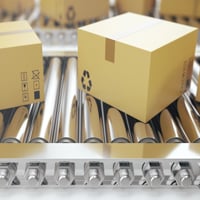
Many types of industries from construction to airlines use conveyor belts to move products and materials in the work environment. Considering the many moving parts and the machinery required to keep conveyor belts working, there is a high level of risk of injury for workers using them. Conveyor belts were responsible for approximately 35 percent of work-related injuries from 2008 to 2012. When workers receive inadequate or incorrect training, are expected to work long hours, or the conveyor belt is not properly maintained, conveyor belt accidents may occur, leading to serious or even fatal injuries.
Injuries Caused by Conveyor Belts
Injuries caused by conveyor belts include: cuts and scrapes; crush injuries and amputations caused when body parts are pulled into the machinery; degloving injuries; burns; and electrocution. Traumatic brain injuries and spinal cord injuries can be caused by objects falling from conveyor belts causing blunt force trauma.
Causes of Conveyor Belt Accidents
There are many different types of conveyor belts. Some start and stop without warning to the employees. Loose clothing, jewelry, or hair can get trapped in conveyor belts. Common causes of conveyor belt accidents include:
- Lack of guards on equipment
- Inadequate or improper training of workers
- Workplace faults that expose workers to conveyor belt hazards
- Incorrect assembly of the conveyor belt
- Inadequate maintenance or inspection of the conveyor belt
- Defective components of the conveyor belt
- Overloading conveyor belts beyond their capacity
- Excessive work speed or conveyor belt speed
Preventing Conveyor Belt Accidents
All employers have a responsibility to run a safe workplace and to take steps to lower the risks if workers are using or working nearby dangerous machinery. The work area layout should eliminate exposure to hazards such as sharp edges or moving parts. Guards or barriers should be utilized to keep the work area safe. Other protective measures such as emergency stop cables should also be in place. Lockout/tagout procedures on equipment should be used so that machinery stops if something goes wrong.
Training is crucial to help avoid conveyor belt injuries. New employees should receive complete training in conveyor belt operation, safety and design. Training programs on safety should be mandatory for employees. It is the employer’s responsibility to provide such training. Without adequate comprehensive training, workers do not know how to recognize hazards and avoid them. Nor do they know how to respond to an accident or emergency.
Maintaining the conveyor belt in good working order is also necessary. Monitoring the number of hours worked can also help minimize the risk of injury. Employees should be encouraged to identify safety risks in the workplace and to report them immediately to their employer.
What if a Worker is Injured in a Conveyor Belt Accident?
A worker who is injured in a conveyor belt accident or other industrial accident may be eligible for Workers’ Compensation benefits. In the event the accident is fatal, the worker’s surviving family members may be entitled to death benefits. If a product defect or faulty equipment caused the accident, in addition to a Workers’ Compensation claim, a worker can file a third-party claim and may seek damages for additional damages such as compensation for pain and suffering.
Pittsburgh Work Injury Lawyers at Alpern Schubert P.C. Recover Maximum Compensation for Injured Workers
If you or someone you love has been injured in a conveyor belt accident or other workplace accident, call Alpern Schubert P.C. today. Our experienced Pittsburgh work injury lawyers are prepared to help you seek compensation for your work-related injuries. Contact us online or call our Pittsburgh, Pennsylvania offices at 412-765-1888 or 800-243-6095 to schedule a free consultation.
